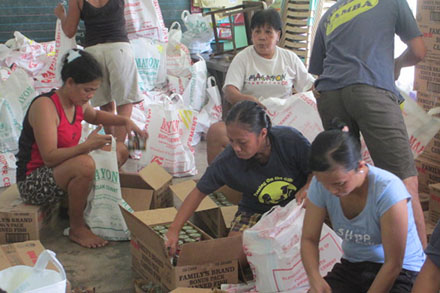All we had to do was ask. When Heifer Philippines asked families for assistance in repacking and organizing goods for the survivors of Typhoon Haiyan, the response was a resounding “Yes.”

This isn’t something that Heifer does very often, but the spirit of giving is strong in the Philippines—as families all over the country know what it is like to suffer from the devastation a typhoon typically brings. And Haiyan was the largest in Filipino history. To help those impacted, and in addition to our other recovery efforts there, Heifer worked with families in Lamba, Legaspi and Albay to pack up goods and supplies for typhoon victims in Leyte. These families are Heifer farmers and partners, not wealthy citizens with extra time or money. These are people who are struggling, too, but were seeking an opportunity to help.
“We are willing to help in repacking relief goods for our brothers and sisters affected by the super typhoon in Eastern Visayas. We are really looking for ways to help them,” said Mario Abaluado, the village chief of Lamba.
Everyone in the Lamba community knows what it is like to recover from a typhoon. Mario was one of them. While loading some goods onto the truck that will be making the delivery to the families he shares, “It is good that Heifer is providing food and other materials…it will help them to bounce back. This provides people a chance to think about rising above the situation, and not just about how to get their next meal.”
If you are interested in our long-term recovery goals in the Philippines after typhoon Haiyan, please join a live roundtable discussion on the phone with Heifer's Vice President of Asia/South Pacific programs, Dr. Mahendra Lohani, at 7 p.m. CST, February 26. To participate, call toll free (855) 756-7520, ext. 23484# To leave questions in advance, email roundtable@list.heifer.org
Volunteers of different ages flocked to the grounds of Lamba Elementary School in mid-December to pitch in. Most were members of partner families of the Anduyog for Families Towards Values-based Sustainable Development and Disaster Management Project. That project ended in June of 2011, but the Heifer legacy continues. The community continues to be active in changing lives and making a difference.
The volunteers packed, loaded and unloaded relief goods for 1,025 families. The goods ranged from food items, such as rice, canned goods, noodles, dried fish, mongo beans, biscuits, milk, coffee and sugar, to health and sanitation essentials like toothbrushes, toothpaste, bath and laundry soap. But they didn’t stop with day-to-day items. As part of the Heifer Philippines sustainability strategy, families also received housing and animal shed materials, such as metal sheets and nails, along with livestock feed, breeding supplies and animal medicines so that their primary income source isn’t disrupted because of the storm.
This is all part of Heifer International’s sustainable, emergency response to the typhoon survivors.
Heifer’s Disaster Risk Reduction and Management (DRRM) is a state-of-the-art disaster prevention/preparedness program used all over the country. The community of Lamba has adopted it as one of their “best practices” and is among many other partner communities of the Heifer International Central Philippines Program.
The Lamba community has received awards for their disaster response work. In 2012 they were recognized with the KALASAG Award. KALASAG is the Filipino term for shield. The KALASAG Award is given by the Filipino government to individuals, non-government organizations, private sector and government organizations to recognize their initiative in helping the Philippines government uplift the standard of disaster management in the country.
“We saw the devastation brought by typhoon Haiyan and it seemed like the 2006 typhoon Reming (locally called Durian) had returned. Reming devastated the Albay province causing damages amounting to 5 billion pesos ($130 million) and killed almost 2,000 people,” shares Julie Abion, a Heifer self-help group member. “We understand how these people feel and the difficulty they are facing. This is our way of repaying the kindness of people who helped us when we were in a similar situation seven years ago. Our fellow groups in Calubian may not know us, and we don’t know them personally. But we share the same spirit of hope and gratitude. We all believe in the Sharing and Caring Cornerstone and since Calubian need help, the families of Lamba had to pass on the kindness.”
Story and Photos by Jonathan Sandigio, Program Officer, Heifer Central Philippines
Edited by Jessica Ford, Global Communications Manager, Heifer International
